IMDEA Networks

SOMIRO: Swimming soft milli-robots to improve water quality monitoring in precision agriculture
The Horizon 2020 EU funded project started on January 1st, 2021, will work to answer the question “Why don’t boosting the use of robotics also in the Agri-food sector?”
20 January 2021

Aligned with digitalization as an integral part of our daily lives and one of Europe’s biggest priority of the next decades, SOMIRO will develop and demonstrate the world’s first energy-autonomous swimming milli-robot with immediate and major impact in the field of robotics and in precision agriculture.
SOMIRO will last three years, with a contribution of about 3 million euros by the European Commission. Coordinated by the Microsystem Technology Division of Uppsala University, meets nine partners (1), from academia and industry, from six different European countries. IMDEA Networks is involved in the project as partner with the role of Work Package leader. The main activity will be the developments of the communication and computing modules for the swimming robot and verify and test its operations in controlled settings. IMDEA will design, prototype and demonstrate a bidirectional and reliable and battery-free visible light communication system that leverages visible light backscattering, and performs computing pushing to the limits power and scale constraints.
The project will be led at IMDEA Networks by Dr. Domenico Giustiniano, Research Associate Professor and leader of the Pervasive Wireless System Group at IMDEA Networks. The project kick-off is foreseen for January 21st and 22nd and IMDEA Networks will participate in order to set up the activities planned for the first 6 months. As Dr. Giustiniano highlights: “Rice production has ancient origins, but it needs to keep up with the technological advancements to be able to be sustainable and reach the needed yield. This project will set an important milestone toward the objective of sustainable rice production in Europe. The key to succeed will be the idea of using tiny and autonomous devices to monitor the environment. This idea is based on the concept of “smart dust”, which was introduced in the early 90s. It is only today that, thanks to the advancements in a variety of technological fields, this concept will become reality. We will contribute with our years of experience in visible light communication and embedded computing to reach this exciting goal in a consortium with tremendous achievements and potential.”
SOMIRO will develop a flat-worm-inspired mm-scale swimming robot with month-long energy autonomy, local intelligence, and ability to continuously generate data and optically communicate. Potential for reducing the environmental impact of farming in terms of carbon footprint, eutrophication, and excessive use of pesticides and feed; covering of a much larger area than stationary systems and could be rapidly deployed and self-redistribute where most needed; service as a stand-alone monitoring solution for indoor farming or complement drone-based remote sensing outdoors. Until today, no energy autonomous (with local intelligence and untethered) milli-robot has been demonstrated capable to withstand hours of continuous operation: the major reason is power limitation: locomotion requires much power and small robots have very limited energy storage and energy uptake.
Milli-robots will be less than 1 cm long and they will not rely on any dedicated infrastructure but only on natural sunlight. They will be tested in two different types of water environment, an aquaponic system and a paddy field, both located in Italy, but in the long-term, SOMIRO will be able to provide new tools for different areas of precision agriculture.
(1) Partners:
Uppsala Universitet (Sweden), École Polytechnique Fédérale de Lausanne (Switzerland), Max Planck Institute for Intelligent Systems (Germany), Universität Linz (Austria), IMDEA Networks Institute (Spain), Mycronic AB (Sweden), Battioli Paola Società Agricola S.S. (Italy), The Circle Società Agricola a Responsabilita Limitata (Italy), Warrant Hub SPA (Italy)


Recent Comments